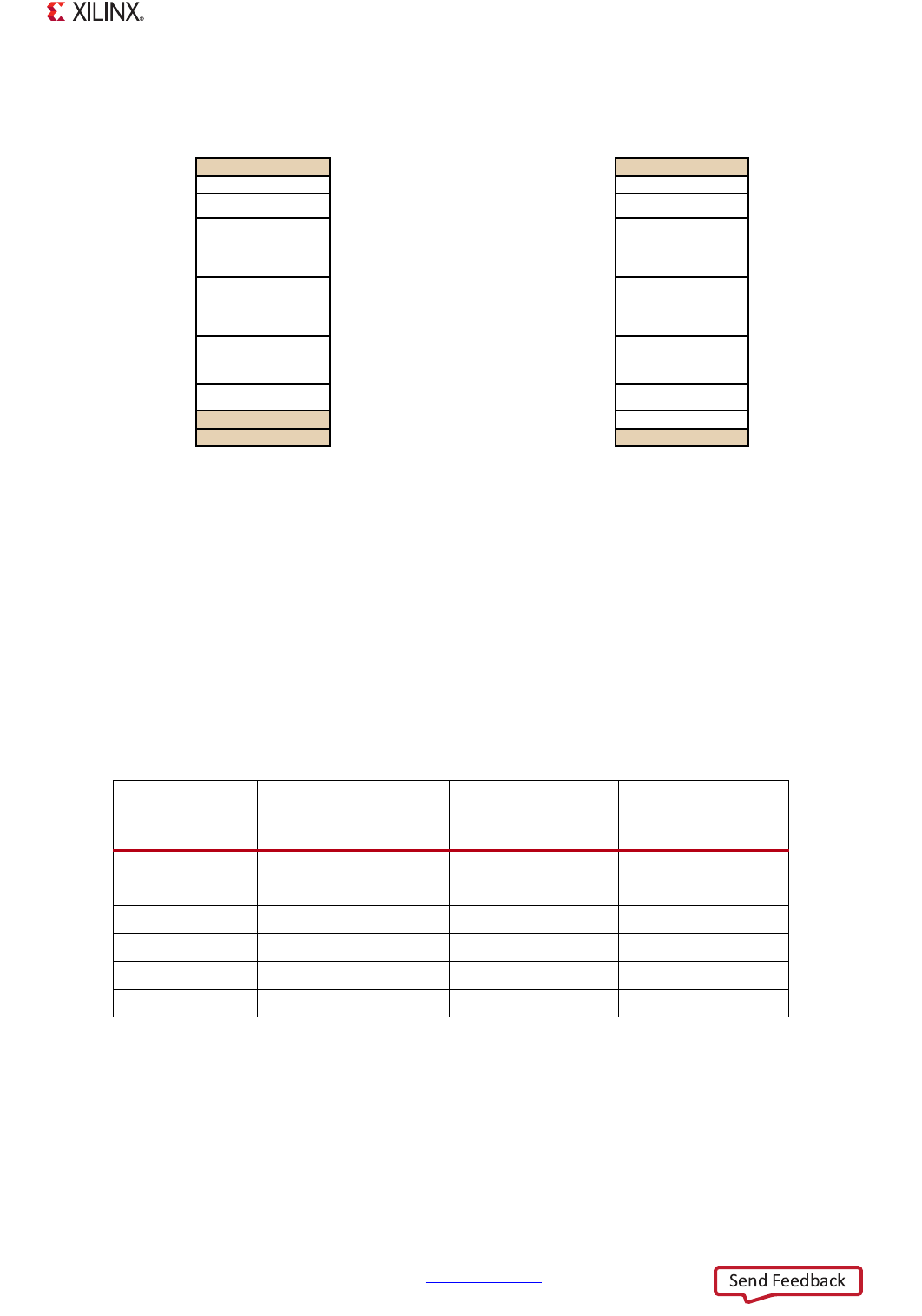User manual
Table Of Contents
- Zynq-7000 All Programmable SoC
- Table of Contents
- Ch. 1: Introduction
- Ch. 2: Signals, Interfaces, and Pins
- Ch. 3: Application Processing Unit
- Ch. 4: System Addresses
- Ch. 5: Interconnect
- Ch. 6: Boot and Configuration
- Ch. 7: Interrupts
- Ch. 8: Timers
- Ch. 9: DMA Controller
- Introduction
- Functional Description
- DMA Transfers on the AXI Interconnect
- AXI Transaction Considerations
- DMA Manager
- Multi-channel Data FIFO (MFIFO)
- Memory-to-Memory Transfers
- PL Peripheral AXI Transactions
- PL Peripheral Request Interface
- PL Peripheral - Length Managed by PL Peripheral
- PL Peripheral - Length Managed by DMAC
- Events and Interrupts
- Aborts
- Security
- IP Configuration Options
- Programming Guide for DMA Controller
- Programming Guide for DMA Engine
- Programming Restrictions
- System Functions
- I/O Interface
- Ch. 10: DDR Memory Controller
- Introduction
- AXI Memory Port Interface (DDRI)
- DDR Core and Transaction Scheduler (DDRC)
- DDRC Arbitration
- Controller PHY (DDRP)
- Initialization and Calibration
- DDR Clock Initialization
- DDR IOB Impedance Calibration
- DDR IOB Configuration
- DDR Controller Register Programming
- DRAM Reset and Initialization
- DRAM Input Impedance (ODT) Calibration
- DRAM Output Impedance (RON) Calibration
- DRAM Training
- Write Data Eye Adjustment
- Alternatives to Automatic DRAM Training
- DRAM Write Latency Restriction
- Register Overview
- Error Correction Code (ECC)
- Programming Model
- Ch. 11: Static Memory Controller
- Ch. 12: Quad-SPI Flash Controller
- Ch. 13: SD/SDIO Controller
- Ch. 14: General Purpose I/O (GPIO)
- Ch. 15: USB Host, Device, and OTG Controller
- Introduction
- Functional Description
- Programming Overview and Reference
- Device Mode Control
- Device Endpoint Data Structures
- Device Endpoint Packet Operational Model
- Device Endpoint Descriptor Reference
- Programming Guide for Device Controller
- Programming Guide for Device Endpoint Data Structures
- Host Mode Data Structures
- EHCI Implementation
- Host Data Structures Reference
- Programming Guide for Host Controller
- OTG Description and Reference
- System Functions
- I/O Interfaces
- Ch. 16: Gigabit Ethernet Controller
- Ch. 17: SPI Controller
- Ch. 18: CAN Controller
- Ch. 19: UART Controller
- Ch. 20: I2C Controller
- Ch. 21: Programmable Logic Description
- Ch. 22: Programmable Logic Design Guide
- Ch. 23: Programmable Logic Test and Debug
- Ch. 24: Power Management
- Ch. 25: Clocks
- Ch. 26: Reset System
- Ch. 27: JTAG and DAP Subsystem
- Ch. 28: System Test and Debug
- Ch. 29: On-Chip Memory (OCM)
- Ch. 30: XADC Interface
- Ch. 31: PCI Express
- Ch. 32: Device Secure Boot
- Appx. A: Additional Resources
- Appx. B: Register Details
- Overview
- Acronyms
- Module Summary
- AXI_HP Interface (AFI) (axi_hp)
- CAN Controller (can)
- DDR Memory Controller (ddrc)
- CoreSight Cross Trigger Interface (cti)
- Performance Monitor Unit (cortexa9_pmu)
- CoreSight Program Trace Macrocell (ptm)
- Debug Access Port (dap)
- CoreSight Embedded Trace Buffer (etb)
- PL Fabric Trace Monitor (ftm)
- CoreSight Trace Funnel (funnel)
- CoreSight Intstrumentation Trace Macrocell (itm)
- CoreSight Trace Packet Output (tpiu)
- Device Configuration Interface (devcfg)
- DMA Controller (dmac)
- Gigabit Ethernet Controller (GEM)
- General Purpose I/O (gpio)
- Interconnect QoS (qos301)
- NIC301 Address Region Control (nic301_addr_region_ctrl_registers)
- I2C Controller (IIC)
- L2 Cache (L2Cpl310)
- Application Processing Unit (mpcore)
- On-Chip Memory (ocm)
- Quad-SPI Flash Controller (qspi)
- SD Controller (sdio)
- System Level Control Registers (slcr)
- Static Memory Controller (pl353)
- SPI Controller (SPI)
- System Watchdog Timer (swdt)
- Triple Timer Counter (ttc)
- UART Controller (UART)
- USB Controller (usb)

Zynq-7000 AP SoC Technical Reference Manual www.xilinx.com 202
UG585 (v1.11) September 27, 2016
Chapter 6: Boot and Configuration
Post BootROM Security
If secure mode is enabled, the AES unit is accessible post BootROM. In non-secure mode, the AES
unit is not accessible.
The BootROM locks several bits in the DevC module prior to exiting to ensure security. The bits the
BootROM locks are listed in Table 6-21; where
1 = locked. The Lock bits are used to disable writes to
bits in the devcfg.CTRL register. Once a lock bit is set, it cannot be cleared except by a POR reset. The
BootROM will lock some of these bits before turning PS control over to the FSPL/User code.
Post BootROM Debug
In the event of a failure while booting non-secure the BootROM enables JTAG access so that the
REBOOT_STATUS and other registers can be read using the DAP controller. A debugging tool like
XMD has full access to the processor when JTAG is enabled and includes the DAP controller in the
chain.
X-Ref Target - Figure 6-11
Figure 6-11: System Memory Map During BootROM Execution
Table 6-21: devcfg.LOCK Register
Bit Position Bit Name
BootROM Secure
Boot Lock Status
BootROM
Non-Secure Boot
Lock Status
31:5 Reserved ~~
4 AES_FUSE_LOCK 10
3 AES_EN_LOCK 0 1
2SEU_LOCK 00
1 SEC_LOCK 10
0DBG_LOCK 00
'XULQJ
%RRW520/RDGLQJ)6%/
8*BFBB
2&05$0
(PSW\
''5
3HULSKHUDOV
(PSW\
2&05$0
0%
*%
0B$;,B*3
0B$;,B*3
*%
*%
*%
.%
$W+DQGRIIIURP
%RRW520([HFXWLRQWR)6%/8VHU&RGH
.%%RRW5203URJUDP0HPRU\
2&0520
.%
.%)6%/&RGHEXIIHU
2&00HPRU\
(PSW\
''5
3HULSKHUDOV
(PSW\
2&00HPRU\
0%
*%
0B$;,B*3
0B$;,B*3
*%
*%
*%
.%
(PSW\
.%
.%)6%/&RGH
3DUDPHWHUV9DULDEOHV
DQG%RRW520+HDGHU
.%%RRW520&RGH
.%)6%/3URJUDP0HPRU\










